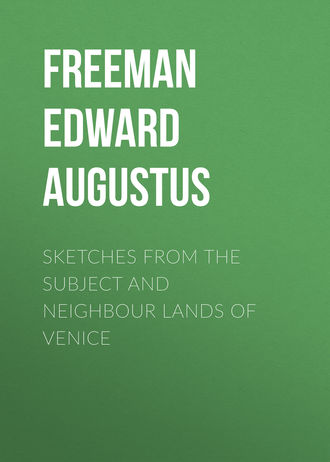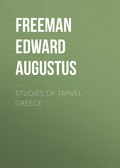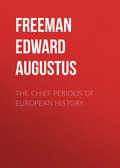
Freeman Edward Augustus
Sketches from the Subject and Neighbour Lands of Venice
CORFU AND ITS HISTORY
1875
We have already spoken of the singular change of name which has befallen the most famous and important, though not the largest in superficial extent, of the group known as the Ionian Islands. The change of name, as we hold, followed naturally on the change of site of the city. The new city took a new name, and the island has always followed the name of the city. The old city and the new both occupy neighbouring points in a system of small peninsulas and havens, which form the middle of the eastern coast of the long and irregularly-shaped island of Korkyra. There, to the south of the present town, connected with it by a favourite walk of the inhabitants of Corfu, a long and broad peninsula stretches boldly into the sea. Both from land and from sea, it chiefly strikes the eye as a wooded mass, thickly covered with the aged olive-trees which form so marked a feature in the scenery of the island. A few houses skirt the base, growing on the land side into the suburb of Kastrades, which may pass for a kind of connecting link between the old and the new city. And from the midst of the wood, on the side nearest to the modern town, stands out the villa of the King of the Greeks, the chief modern dwelling on the site of ancient Korkyra. This peninsular hill, still known as Palaiopolis, was the site of the old Corinthian city whose name is so familiar to every reader of Thucydides. On either side of it lies one of its two forsaken harbours. Between the old and the new city lies the so-called harbour of Alkinoos; beyond the peninsula, stretching far inland, lies the old Hyllaic harbour, bearing the name of one of the three tribes which seem to have been essential to the being of a Dorian commonwealth. But the physical features of the country have greatly changed since Chersikratês led thither his band of settlers twenty-six centuries back. It is plain that both harbours once came much further inland than they do now, that they covered a great deal of the low ground at the foot of the peninsular hill. The question indeed presents itself, whether the two did not once meet, whether the peninsula was not once an island, whether the original colony did not occupy a site standing to the mainland of Korkyra in exactly the same relation in which the original insular Syracuse, the sister Corinthian colony, stood to the mainland of Sicily. The physical aspect of the country certainly strongly suggests the belief. And though Thucydides does not directly speak of the city as insular, though his words do not at all suggest that it was so, yet we do not know that there is anything in his narrative which directly shuts out the idea. Anyhow, the great change which has happened is plain when we see how utterly the great Hyllaic haven has lost the character of a haven. It is now called a lake, and exists only for purposes of fishing. We may believe that these physical changes had a great deal to do with the removal of the city to another site, with the change from Korkyra to Corfu.
The description which Thucydides gives of the great sedition brings out a fact which we should at first sight hardly have expected, the fact that the aristocratic quarter of Korkyra was on the lower ground by the harbour, while the upper part of the town was occupied by the dêmos. To one who thinks of Rome, Athens, and ancient cities generally, this seems strange. But arguments from the most ancient class of cities do not fully apply to cities of the colonial class. These, where commerce was so great an object, were no longer, as a rule, placed on heights; convenient access from the sea was a main point, and we can therefore understand that the ground by the coast would be first settled, and would remain the dwelling-place of the old citizens, the forefathers of the oligarchs of the great sedition. There on the lower ground was the agora, where the Epidamnian exiles craved for help, and pointed to the tombs of their forefathers. The impression of the scene becomes more lively when we see not far off an actual ancient tomb remaining in its place, though it could hardly have been the tomb of the forefather of any Epidamnian. This is the tomb of Menekratês of Oianthê, honoured in this way by the people of Korkyra on account of his friendship for their city, a plain round tomb with one of those archaic inscriptions in which Korkyra is rich. Archaic indeed it is, written from right to left, in characters which mere familiarity with the Greek of printed books or of later inscriptions will not enable any one to read off with much ease. It formed doubtless only one of a range of tombs, doubtless outside the city, but visible from the agora. An orator in the Roman forum could not have pointed to the tombs of forefathers by the Appian Way.
The position of the quarter of the oligarchs by the modern suburb of Kastrades seems perfectly clear from Thucydides. The dêmos took refuge in the upper part of the city and held the Hyllaic harbour; the other party held the agora, where most of them dwelled, and the harbour near it and towards the continent (οἱ δὲ τήν τε ἀγορὰν κατέλαβον, οὗπερ οἱ πολλοὶ ᾤκουν αὐτῶν, καὶ τὸν λιμένα τὸν πρὸς αὐτῇ καὶ πρὸς τὴν ἤπειρον). This district marks out the haven by Kastrades, looking out on the Albanian mountains, as distinguished from the Hyllaic haven shut in by the hills of Korkyra itself.
But where was the Hêraion, the temple of Hêrê, which plays a part in more than one of the Thucydidean narratives? and where was the island opposite to the Hêraion – πρὸς τὸ Ἡραῖον – and the isle of Ptychia, both of which appear in his history? The answer to the former question seems to turn on another. Was the present citadel, the true Κορυφώ, itself always an island, as it is now? The present channel is artificial – that is to say, it is made artificial by fortifications – but it may after all have been a natural channel improved by art. And that is the belief of some of the best Corfiote antiquaries. If so, this may well be the νῆσος πρὸς τὸ Ἡραῖον, and Ptychia may be the isle of Vido beyond. The Hêraion would thus stand on the north side of the old Korkyra, looking towards the modern city; it would stand in the oligarchic quarter on the low ground near the agora. It was therefore neither of the two temples of which traces remain. One, of which the walls can be traced out nearly throughout, and of which a single broken Doric column is standing, overlooks the open sea towards Epeiros. Another on the other side overlooked the Hyllaic harbour. This in course of time became a church, a now ruined church, but which keeps large parts of its Hellenic walls and some windows of beautiful Byzantine brickwork. It seems hardly possible in any case that the Hêraion could have been at quite the further end of the peninsula, and that the island πρὸς τὸ Ἡραῖον could be either of the small islands, each containing a church, which keep the entrance of the Hyllaic harbour.
Such then was old Korkyra, the colony of Chersikratês, the Korkyra which figures in the tale of Periandros, the Korkyra which played such a doubtful part in the Persian War, which gained so fearful a name in the Peloponnesian War, and which, within two generations, had so thoroughly recovered itself that in the days of Timotheos it struck both friends and enemies by its wealth and flourishing state. It is the Korkyra of Pyrrhos and Agathoklês, the Korkyra which formed one of the first stepping-stones for the Roman to make his way to the Hellenic continent, the Korkyra whose history goes on till the wasting inroad of Totilas. Then, as we hold, ancient Korkyra on its peninsula began to give way to Koryphô (Corfu) on another peninsula or island, that to which the two peaks which form its most marked feature gave its name.

CHURCHES AT CORFU.
This last is the Corfu whose fate seems to have been to become the possession of every power which has ruled in that quarter of the world, with one exception. For fourteen hundred years the history of the island is the history of endless changes of masters. We see it first a nominal ally, then a direct possession, of Rome and of Constantinople; we then see it formed into a separate Byzantine principality, conquered by the Norman lord of Sicily, again a possession of the Empire, then a momentary possession of Venice, again a possession of the Sicilian kingdom under its Angevin kings, till at last it came back to Venetian rule, and abode for four hundred years under the Lion of Saint Mark. Then it became part of that first strange Septinsular Republic of which the Tzar was to be the protector and the Sultan the overlord. Then it was a possession of France; then a member of the second Septinsular Republic under the hardly disguised sovereignty of England; now at last it is the most distant, but one of the most valuable, of the provinces of the modern Greek kingdom. But Corfu has never for a moment been under the direct rule of the Turk. The proudest memory in the later history of the island is the defeat of the Turks in 1716. Peloponnêsos, the conquest of Morosini, had again been lost, and the Turk deemed that he might again carry his conquests into the Western seas. The city was besieged by land and sea; the two fleets, Christian and infidel, stretched across the narrow channel between the island and the mainland, the left wing of the Turkish fleet resting strangely enough on Venetian Butrinto, while the ships of Venice and her allies stretched from Vido to the Albanian shore. The statue of Schulemberg, set up as an unparalleled honour in his lifetime, adorns the esplanade of the city which he saved. Unless we count the Turkish acquisition of the Venetian points on the mainland, which, though done under the cover of a treaty, took at Prevesa at least the form of an actual conquest, this was the last great attempt of the Turk to extend his dominion by altogether fresh conquests at the expense of any Christian power.
Korkyra thus gave way to Corfu, and the endless fortifications of Corfu of every date were largely built out of the remains of Korkyra which supplied so convenient a quarry. None but an accomplished military engineer could attempt to give an account of the remains of all the fortifications, Venetian and English, dismantled, ruined, or altogether blown up. But the kingdom of which Corfu now forms a part still keeps the insular citadel, the outline of the two peaks being sadly disfigured by the needs of modern military defence. Of the modern city there is but little to say. As becomes a city which was so long a Venetian possession, the older part of it has much of the character of an Italian town. It is rich in street arcades; but they present but few architectural features, and we find none of those various forms of ornamental window, so common, not only in Venice and Verona, but in Spalato, Cattaro, and Traü. The churches in the modern city are architecturally worthless. They are interesting so far as they will give to many their first impression of Orthodox arrangement and Orthodox ritual. The few ecclesiastical antiquities of the place belong to the elder city. The suburb of the lower slope of the hill contains three churches, all of them small, but each of which has an interest of its own. Of one, known as ἡ Παναγία τῶν βλαχερνῶν , we have already spoken; another, known specially as Our Lady of Oldbury (ἡ Παναγία παλαιοπόλεως), is unattractive enough from any point from which the spectator is likely to see it. Its form is by courtesy called basilican; but, if so, it is like the basilica of Trier, without columns or arches. Within it is a dreary building enough, but it presents one object of interest in a side-altar, a Latin intrusion into the Orthodox fabric. But the west end is one of the most memorable things to be found in Corfu or anywhere else. Two columns, not of the usual early Doric of the island, but with floriated capitals, though not exactly Corinthian, are built into the wall with a piece of their entablature. On this is graven a Christian inscription, which is given in an inaccurate shape by Mustoxidi (Delle cose Corciresi, p. 405), who has further improved the spelling. The spelling is in truth after the manner of Liudprand and the modern shoe-makers of Corfu, and is therefore instructive. At the top come the words of the Psalmist; "This is the gate of the Lord; the writeous shall enter into it": – αὕτη ἡ πύλη τοῦ Κυρίου, δίκεοι εἰσελεύσονται ἐν αὐτῇ. Below come four hexameters: —
πίστιν ἔχων βασίλιαν ἐμῶν μενέων συνέριθον,
σοὶ μάκαρ ὑψιμέδον τόνδ' ἱερὸν ἔκτισα ναὸν,
Ἑλλήνων τεμένη καὶ βωμοὺς ἐξαλαπάξας,
χειρὸς ἀπ' οὐτιδανῆς Ἰοβιανὸς ἔδωκεν ἄνακτι.
Who was this Jovianus? Clearly a Christian as zealous as his Imperial namesake; for he cannot be the Emperor himself, as some have thought. He thought it glory and not shame to destroy the works of the Gentiles – the Ἕλληνες – and to turn them to the service of the royal faith. But are we to take the "royal faith" in the same sense as the "royal law" of the New Testament? or does it mean the "royal faith," as being set up under some orthodox Emperor, when the orthodoxy of Emperors was still a new thing? Anyhow the plunderer of Gentile temples and altars could not keep himself from something of the Gentile in the ring and the language of his verses. And had he made use of his spoil to rear a basilica like those of Constantine and Theodoric, we should, from a wider view than that of the mere classical antiquary, have but little right to blame him. The rest of the columns, besides the two that are left, would have well relieved the bareness of his interior; better still would it have been if Saint Peter ad Vincula had found a rival in two arcades formed out of the Doric columns whose fragments lie about at Corfu, almost as Corinthian and Composite fragments lie about at Rome. The third church, that which professes to be the oldest in the island, that which bears the name of the alleged apostles of the island, the Jasôn and Sosipatros of the New Testament, is a more successful work. Brought to its present form about the twelfth century by the priest Stephen, as is recorded in two inscriptions on its west front, it is, allowing for some modern disfigurements, an admirable specimen of a small Byzantine church. It will remind him who comes by way of Dalmatia of old friends at Zara, Spalato, and Traü; but it has the advantage over them of somewhat greater size, and of standing free and detached, so that the outline of its cross, its single central cupola and its three apses, may be well seen. This church, like most in the neighbourhood, has a bell-gable – κωδωνοστάσιον – with arches for three bells, of a type which seems to be found of all ages from genuine Byzantine to late Renaissance.

SAINT JASON AND SAINT SOSIPATROS, CORFU.
To go back to earlier times, the museum of Corfu contains an inscription, βουστροφηδόν inscription, rivalling that of Menekratês in its archaism, attached to a Doric capital, of far later workmanship, one would have thought, than the inscription. The building art had clearly outstripped the writing art. The military cemetery contains some beautiful Greek sepulchral sculptures from various quarters, not all Korkyraian. And at some distance from the city, near the shore of Benizza – a name of Slavonic sound – is a Roman ruin with mosaics and hypocaust, whose bricks we think Mr. Parker would rule to be not older than Diocletian. In Corfu such a monument seems at first sight to be out of place. For Hellenic remains, for Venetian remains, we naturally look; still it is well to have something of an intermediate day, something to remind us of the long ages which passed between the revolutions recorded by Polybios and the revolutions recorded by Nikêtas.
CORFU TO DURAZZO
1881
We start again from Corfu, and this time our course is northward. A survey of Greece as Greece would lead us southward and eastward. So would even a complete survey of the subject lands of Venice. For that we must go on to the rest of the western islands, to not a few points in the Ægæan, to the greater islands of Euboia and Crete, to Saint Mark's own realm of Cyprus, which the Evangelist so strangely inherited from his daughter and her son. Not a few points of Peloponnêsos for some ages, all Peloponnêsos for a few years, Athens itself for a moment, comes within the same range. We might write the history of Argos from the Venetian point of view, a point of view which would shut out the history of Mykênê, and would look on Tiryns only as Palai-Nauplia, the precursor of Napoli di Romania. But no man could journey through Greece itself with Venice in this way in his thoughts. Far older, far nobler, memories would press upon him at every moment. The mediæval history of Greece is a subject which deserves far more attention than it commonly gets, and in that history Venice plays a prominent part. But it is hard, in a Greek journey, to make the mediæval history primary, and even in the mediæval history Venice is only one element among others. A large part of Greece fairly comes under the head of the Subject and Neighbour Lands of Venice; but we cannot bring ourselves to make that the chief aspect in which we look at them. It is otherwise with the Dalmatian and Albanian possessions of the Republic. There, though other points of view are possible, yet the special Venetian point of view is one which may be both easily and fairly taken. So too with Corfu; thoroughly Greek as the island is, it still lies on the very verge of continuous Greece. In its history and geography it is closely connected with the more northern possessions of the Republic; its Venetian side is at least as important as any other side; we can without an effort bring ourselves to treat it in a way in which we could hardly bring ourselves to treat Argos. We can then fairly take Corfu into our special Venetian survey; but we can hardly venture to carry that survey further. The rest of Greece, though it has its Venetian side, though it is important that its Venetian side should not be forgotten, can never be looked on in this way as an appendage to the Hadriatic commonwealth. We cannot go through the earliest homes of European civilization and freedom, and keep our mind mainly fixed even on the days when Rome had made them members of her Empire, and when their influence had gone far to make the later power of Rome at least as much Greek as Roman. Still less can we go through them with our mind mainly fixed on the days when so large part of Greece had passed under the rule of a city which was in truth a revolted member of the Empire which it helped to split in pieces.
We start then again from Corfu, with our faces turned towards our old haunts among the Illyrian coasts and islands. In so doing, we pass for a while out of the Christian and civilized world, to skirt along the coasts where Europe is still in bondage to Asia. The wrong is an old one, as old as the days when Herodotus put on record how Greek cities for the first time passed under the rule of a barbarian master. From his day, from times long before his day, from the days of Agamemnôn, perhaps from the days of the brave men who lived before him, the same long strife has been going on, the same "eternal Eastern question" has been awaiting its "solution." And nowhere does that abiding struggle come more fully home to us than in the lands where the Eastern question has become a Western question. The Greek cities whose bondage to the barbarian was recorded by Herodotus were Greek cities on barbarian ground. They were outposts of Europe on the soil of Asia; they were spots in winning which the Asiatic might deem that he was winning back his own. And after all, the barbarian whose conquest of the Greek cities of Asia marks one important stage in this long strife, was a barbarian of another kind from the barbarians whom European lands have in later times been driven to receive as masters. Crœsus worshipped the Gods of Greece, and Greek poets sang his praises. It may even be that the Lydian, like the Persian who succeeded him, was not a barbarian at all in the strictest sense, but that there was some measure of kindred, however distant, between him and his European subjects. It is another kind of master, another kind of bondage, which has fallen to the lot of the lands along whose coast we are now sailing. Here we do indeed see the West in bondage to the East, we do indeed see Europe on her own soil bowed down beneath the yoke of Asia. We pass by coasts which look to the setting sun no less than our own island, but which the Asiatic intruder still holds beneath the yoke, – over some of which he has pressed the yoke for the first time within the memory of living men. On these coasts at least we think of Venice only in her nobler character. Here indeed every island, every headland, which owned her rule, was something saved from the grasp of the enemy; it was indeed a brand plucked from the burning. As we sail northward, we leave spots behind us, memorable in past times, memorable some of them in our own day. We leave behind us Prevesa, where, till almost within our own century, Saint Mark still held his own, hard by the City of Victory of the first Emperor. We remember how Prevesa was torn away from Christendom by the arms of Ali of Jôannina, and how within the last three years freedom has been twice promised to her but never given. We leave behind us more famous Parga, where, within the lifetime of many of us, stout hearts could still maintain their freedom, in the teeth alike of barbarian force and of European diplomacy – Parga, whose banished sons bore with them the bones of their fathers rather than leave them to be trampled on by the feet of the misbelievers. There must be men still living who had their share in that famous exodus, and who have lived to see Europe first decree that their land should be again set free, and then thrust it back again beneath the yoke. We leave behind us Butrinto, happier at least in this, that there no promise of later days has been broken. There we have passed the point beyond which assembled Europe ruled that even the dreams of freedom might go no further. And as we sail between the home of freedom and the house of bondage, our thoughts overleap the mountain wall. They fly to the heights where Souli, birth-place of Botzarês, is left to the foes against whom it so long and so stoutly strove. They fly to Jôannina, so long the home of light and comparative freedom amid surrounding darkness and bondage, but which now, instead of receiving the twice-promised deliverance, is again thrust back into bondage for a while. We pass on by the High Thunderpeaks, fencing in the land of Chimara, famous in the wars of Ali. We double the promontory of Glôssa, and find ourselves in the deep bay of Aulôn, Aulona, Valona, with the town itself high on its hill, guarding the entrance to the gulf from the other side. Here is a true hill-city, unlike Korkyra, unlike even Buthrotum; but while Korkyra and Buthrotum, each on its shore, has each its history, Aulôn on its height has none. We pass by the mouths of the great Illyrian rivers, by Aoos and Apsos, and we leave between them the place where once stood Apollonia, another of the paths by which Rome made her way into the Eastern world. At last we find ourselves in another bay, wider, but not so deep as the bay of Aulôn. Here we look out on what remains of a city whose earlier name dwells in the memory of every reader of the greatest of Greek historians, a city whose later name, famous through a long series of revolutions, ought to be ever fresh in the minds of Englishmen, as having become by a strange destiny the scene of one stage of the same struggle as Senlac and York and Ely. The city on which we look was, under its elder name of Epidamnos, that famous colony of Korkyra which gave an occasion for the Peloponnesian war. Under its later name of Dyrrhachion or Durazzo it beheld Englishmen and Normans meet in arms, when Englishmen driven from their homes had found a shelter and an honourable calling in the service of the Eastern Cæsar.
The city on which we gaze, though it is only by a figure that we can be said to gaze on the original Epidamnos, is one of those cities which, without ever holding any great place themselves, without being widely ruling cities, without exercising any direct influence on the course of the world's history, have given occasion for the greatest events through their relations to cities and powers greater than themselves. Under none of its names was Epidamnos the peer of Corinth in the elder state of things, or of Venice in the later. Yet events of no small moment came of the relations between Epidamnos and Corinth, of the relations between Durazzo and Venice. Greater events still came of the relations between Dyrrhachion and Rome. The three names, though of course the third is a simple corruption of the second, are convenient to mark three periods in the history of the place, just as one of the great Sicilian cities is conveniently spoken of at three stages of its life as Akragas, Agrigentum, and Girgenti. When and how the name changed from Epidamnos to Dyrrhachion is not clear, nor are the reasons given for the change satisfactory. In practice, Epidamnos is its old Greek name, Dyrrhachion its Roman, Durazzo its mediæval name. But the name Dyrrhachion can be Roman only in usage; the word itself is palpably Greek. In strictness it seems that Epidamnos was the name of the city, and Dyrrhachion the name of the peninsula on which the city was built. The change then has some analogy with the process by which the tribal names in northern Gaul have displaced the elder names of their chief cities, or with the change among ourselves by which Kingston-on-Hull, as it is still always called in formal writings, is in common speech always spoken of as "Hull." Anyhow, under Roman rule, the name of Dyrrhachion altogether displaced Epidamnos. The new name gradually came to be mispelled or Latinized into Durachium and Duracium, and, in that state, it supplied the material for more than one play upon words. When Robert Wiscard came against it, he said that the city might indeed be Duracium, but that he was a dour man (durus) and knew how to endure (durare). The Norman made his way by this path into the Eastern lands, as the Roman had done before him; but as his course was quicker, his stay was shorter. Epidamnos, along with Apollônia and Korkyra, were the first possessions of Rome east of the Hadriatic. They were possessions of the ruling city where dominion was for a long time disguised under the name of alliance. But, under whatever name, Rome, Old and New, held them till the Norman came. But the Norman did not hold them till the Venetian came. In a few years after the coming of Robert Wiscard, Durazzo and Corfu were again cities of the Eastern Empire.
Amidst all the revolutions which this little peninsula has gone through, one law seems to hold. Under all its names, it has had in a marked way what we may call a colonial life, in the modern sense of the word colonial. It has ever been an outpost of some other power, of whatever power has been strongest in those seas, and it has been an outpost ever threatened by the elder races of the mainland. Herein comes one of the differences between this Albanian coast and the Dalmatian coast further north. The Roman Peace took in all; but in the days before and after the Roman Peace, the settlements of Corinth, Venice, or any other colonizing and civilizing power, along the coast of which Durazzo was the centre, were merely scattered outposts. There never was that continuous fringe of a higher culture, Italian or Greek, which spread along the whole coast further north. As a colony, an isolated colony, Epidamnos or Durazzo was always exposed to the attacks of barbarian neighbours. And in this land the barbarian neighbours have always been the same. The old Illyrian, the Albanian, the Arnaout, the Skipetar – call him by whichever name we will – has here lived on through all changes. He has indeed a right to look on Greek, Roman, Norman, Angevin, Servian, Venetian, and Ottoman, as alike intruders within his own immemorial land. It was danger from the Illyrian that led to the disputes which open the history of Thucydides, when Corinth and Korkyra fought over their common colony. It was danger from the Illyrian which drove Epidamnos into the arms of Rome. It was the Illyrian under his new name who in the fourteenth century for a moment made Durazzo the head of a national state, the capital of a short-lived kingdom of Albania. Twice conquered by the Normans of Apulia and Sicily, twice by their Angevin successors, granted as part of a vassal kingdom by the Norman and as a vassal duchy by the Angevin, twice won by the Venetian commonwealth, held by the despots of Epeiros, by the restored Emperors of Constantinople, by the kings of Servia, by the native kings of Albania, no city has had a more varied succession of foreign masters; but, save in the days of the old Epidamnian commonwealth and in the days of the momentary Albanian kingdom, it has always had a foreign master of some kind. But in the endless succession of strangers which this memorable spot has seen, as masters, as invaders, as defenders, it is the Englishman and the Venetian who can look with most satisfaction on their share in its long history. Englishmen had the honour of guarding the spot for the Eastern Cæsar; Venice had the honour of being the last Christian champion to guard it against the Ottoman Sultan.
We stand then gazing from our ship on what is left of the city which Robert Wiscard crossed the sea to conquer, which Alexios came with his motley host to defend, and to find that in all that host the men whom he could best trust were the English exiles. There, as in their own island, the English axe and the Norman lance clashed together; there the stout axemen alone stayed to die, while the other soldiers of the Eastern Rome, the Greek, the Turk, and the Slave, all turned to fly around their Emperor. We look out, and we long to know the site of the church of Saint Michael, which our countrymen so stoutly guarded, till the Normans, Norman-like, took to their favourite weapon of fire. But may we confess to the weakness of looking at all these things only from the deck of the steamer? Perhaps there are some who may be forgiven if they shrink from thrusting themselves alone, with no native or experienced guide, into the jaws of the present masters of Durazzo. They may be the more forgiven when those who have the care of their vessel and its temporary inhabitants utter warnings against any but the most stout-hearted trusting themselves to the boats which form the only means of reaching the Dyrrhachian peninsula. Strengthened in weakness by such counsels, there seems a kind of magnanimity in the resolution to abide in the ship, to say that we have landed at free Corfu, that we shall land at recovered Antivari, but that we will not betweenwhiles set foot on any soil where the Turk still reigns. And the time of distant gazing is not wasted. Without risking ourselves either on Turkish ground or on the rough waves of the Epidamnian bay, a fair general view of the city may be had from the steamer. The wide curve of the bay has for the most part a flat shore, with a background of mountains in the distant landscape. Towards the north-west corner, a promontory of a good height, backed by a comb-like range of peaks, rises at once from the water. This is the peninsula of Dyrrhachion, once crowned by the Epidamnian city. The modern town is seen on a small part of the tower slope of the hill. The walls can be traced through the greater part of their circuit; a huge round bastion by the sea, more than one tower, round and square, teach us that Durazzo has been strongly fortified. If we may eke out our own distant impressions by the help of an old print showing what Durazzo was in times past, we see that it was fortified indeed. We can recognize in the picture most of the towers which we have seen with our own eyes, and there is shown also another tower far greater, a huge square tower of many stages, which no imagination of the artist can have devised out of anything which now comes into the sea-view of the city. But that view enables us to trace out a few buildings within the wall. We mark the distinctive symbols of the two stranger forms of worship, from the East and from the West, which have, each in its turn, supplanted or dominated the native Church. The Latin church, with its conspicuous bell-tower, carries on the traditions of Angevin and Venetian rule; the mosque, with its more conspicuous minaret, speaks of the more abiding dominion of the representative of the False Prophet. The native church meanwhile lurks significantly unseen in the general view. Our teacher on board our ship assures us that Durazzo is not without an Orthodox place of worship; but he cannot point out its whereabouts.







